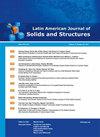复合材料模拟网格缩减的广义有限元界面法
IF 1.1
4区 工程技术
Q3 ENGINEERING, CIVIL
引用次数: 0
摘要
本文章由计算机程序翻译,如有差异,请以英文原文为准。
A generalized finite element interface method for mesh reduction of composite materials simulations
This paper proposes interface and polynomial enrichments using the generalized finite element method (IGFEM) for the material interface in composite materials without matching the finite element mesh to the boundaries of different materials. Applications in structural members such as laminated beams and heterogeneous composites (matrix and inclusions) employing coarse and fine meshes are employed. The results were compared with conventional GFEM and analytical solutions. Verification and simulations proved the efficiency of the suggested framework for solving problems with discontinuous gradients resulting from a material interface. The proposed method allows flexibility in mesh generation for composite materials by letting the interface be embedded in an element without the need to match the mesh to the material interface. This improves the computational efficiency over conventional methods.
求助全文
通过发布文献求助,成功后即可免费获取论文全文。
去求助
来源期刊
CiteScore
2.80
自引率
8.30%
发文量
37
审稿时长
>12 weeks

 求助内容:
求助内容: 应助结果提醒方式:
应助结果提醒方式:


